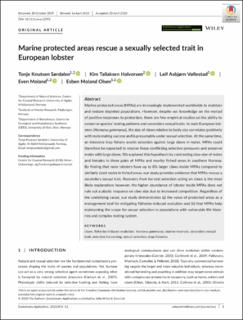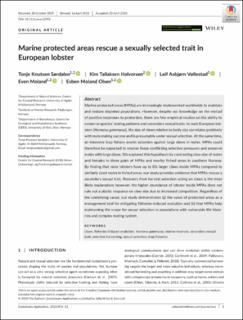| dc.contributor.author | Sørdalen, Tonje Knutsen | |
| dc.contributor.author | Halvorsen, Kim Aleksander Tallaksen | |
| dc.contributor.author | Vøllestad, Leif Asbjørn | |
| dc.contributor.author | Moland, Even | |
| dc.contributor.author | Olsen, Esben Moland | |
| dc.date.accessioned | 2020-10-15T12:18:12Z | |
| dc.date.available | 2020-10-15T12:18:12Z | |
| dc.date.created | 2020-08-03T13:33:42Z | |
| dc.date.issued | 2020 | |
| dc.identifier.citation | Evolutionary Applications. 2020, 1-12. | en_US |
| dc.identifier.issn | 1752-4571 | |
| dc.identifier.uri | https://hdl.handle.net/11250/2683099 | |
| dc.description.abstract | Marine protected areas (MPAs) are increasingly implemented worldwide to maintain and restore depleted populations. However, despite our knowledge on the myriad of positive responses to protection, there are few empirical studies on the ability to conserve species’ mating patterns and secondary sexual traits. In male European lobsters (Homarus gammarus), the size of claws relative to body size correlates positively with male mating success and is presumably under sexual selection. At the same time, an intensive trap fishery exerts selection against large claws in males. MPAs could therefore be expected to resolve these conflicting selective pressures and preserve males with large claws. We explored this hypothesis by contrasting claw size of males and females in three pairs of MPAs and nearby fished areas in southern Norway. By finding that male lobsters have up to 8% larger claws inside MPAs compared to similarly sized males in fished areas, our study provides evidence that MPAs rescue a secondary sexual trait. Recovery from harvest selection acting on claws is the most likely explanation; however, the higher abundance of lobster inside MPAs does not rule out a plastic response on claw size due to increased competition. Regardless of the underlying cause, our study demonstrates (a) the value of protected areas as a management tool for mitigating fisheries‐induced evolution and (b) that MPAs help maintaining the scope for sexual selection in populations with vulnerable life histories and complex mating system. | en_US |
| dc.language.iso | eng | en_US |
| dc.title | Marine protected areas rescue a sexually selected trait in European lobster | en_US |
| dc.type | Peer reviewed | en_US |
| dc.type | Journal article | en_US |
| dc.description.version | publishedVersion | en_US |
| dc.source.pagenumber | 1-12 | en_US |
| dc.source.journal | Evolutionary Applications | en_US |
| dc.identifier.doi | 10.1111/eva.12992 | |
| dc.identifier.cristin | 1821342 | |
| cristin.ispublished | true | |
| cristin.fulltext | original | |
| cristin.fulltext | original | |
| cristin.qualitycode | 1 | |

